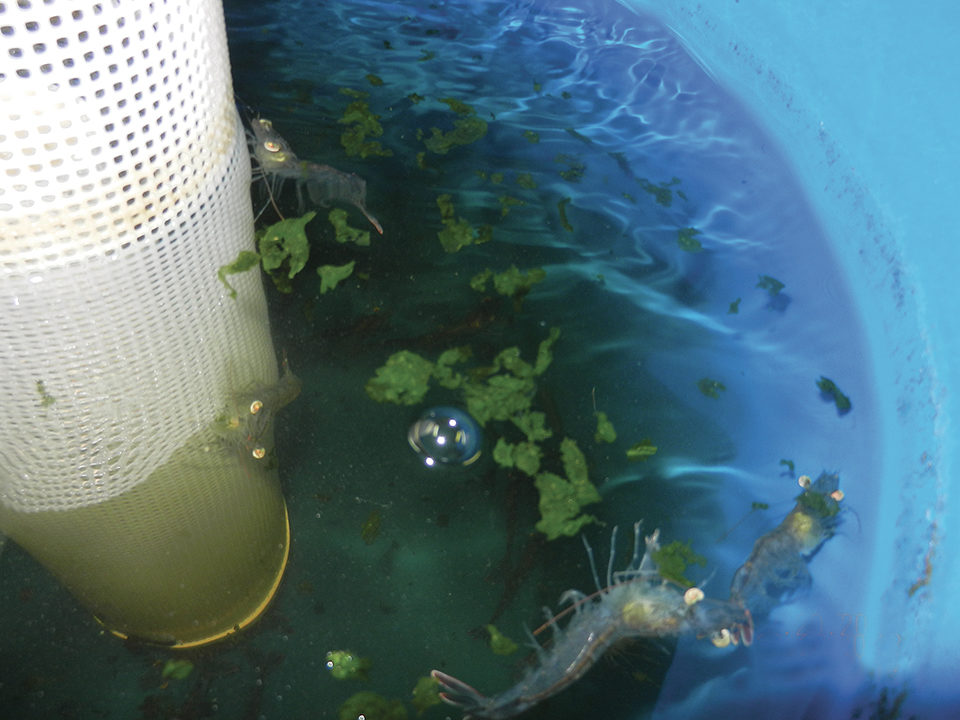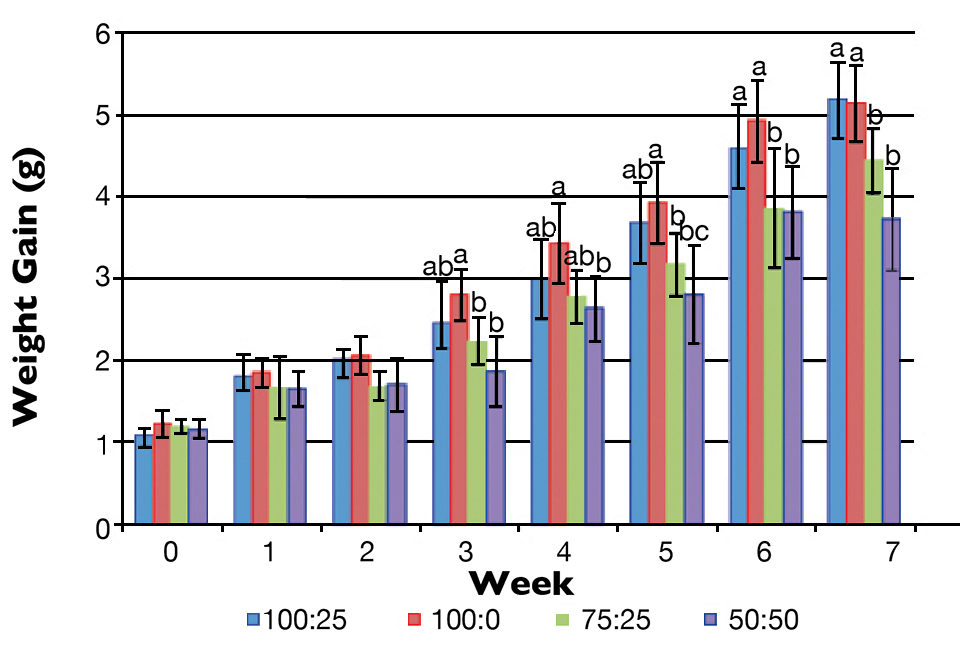Growth, survival rates not significantly improved

Researchers at the Harbor Branch Oceanographic Institute at Florida Atlantic University (HBOI-FAU) have designed a unique type of land-based integrated multi-trophic aquaculture (IMTA) system that uses a centralized filtration system to deliver controlled volumes of selected pretreated waste streams to each system component.
Fed components in this system include Florida pompano (Trachinotus carolinus) and Pacific white shrimp (Litopenaeus vannamei). The macroalga Ulva lactuca is used to manage the nitrogenous waste produced in the system. The pompano are reared in a clearwater system, and the shrimp are cultured in a heterotrophic system maintained by inputs of biofloc from an external bioreactor.
During the course of trials with the system, it was noted that the fed shrimp grazed on small pieces of U. lactuca contained in the solids generated by the system, as well as on the produced biofloc. Macroalgae are considered a good source of vitamins, minerals and proteins, and have been used as a dietary supplement in the culture of sea bass, snakehead and shrimp. Seaweed polyculture has been reported to increase growth and decrease feed-conversion ratios in addition to assimilating nutrients from culture water, resulting in improved water quality. In addition to performing an assimilative function, U. lactuca has potential economic value as a food source.
The productivity of U. lactuca cultured in the HBOI-FAU system is 20 grams dry weight/m2/day. Proximate analysis of the U. lactuca determined it had 34 percent protein on a dry-weight basis. Due to the high protein content, as well as the observation that shrimp in the system found it a palatable addition to a pelleted diet, a study was conducted examining the potential utilization of fresh U. lactuca harvested from the system as a supplement or partial replacement of the pelleted diet, thereby adding economic value to the system by decreasing feed costs.
Experimental design
The study was carried out in a clearwater recirculating aquaculture system within a climate-controlled greenhouse at HBOI-FAU in Fort Pierce, Florida, USA. The system incorporated a sand filter, bead biofilter and ultraviolet sterilization with 20, 80-L circular fiberglass tanks.
The four experimental treatments groups consisted of a 100 percent pelleted feed control (100:0), pelleted feed plus a 25 percent algae supplement (100:25), pelleted feed with 25 percent algae replacement (75:25) and pelleted feed with 50 percent algae replacement (50:50). The pelleted diet contained 45 percent protein and 11.5 percent fats. The Ulva contained 34 percent protein and 2 percent fats on a dry-weight basis.
Thirty juvenile shrimp weighing 1.17 ± 0.12 grams each were stocked into each tank following a random block design with six replicates each. The shrimp were fed the pelleted diet at 9 a.m. and 4 p.m. and received U. lactuca daily at 11 a.m. Temperature, salinity and dissolved-oxygen levels were maintained at 25.0 to 27.7 degrees-C, 30.8-33.8 g/L and 85.7 to 105.9 percent, respectively. Total ammonium nitrogen, nitrite and alkalinity levels averaged 0.084 mg/L, 0.093 mg/L and 185.200 mg/L, respectively.
Twenty percent of the population of each tank was randomly weighed on a weekly basis. At the end of the trial, all shrimp were harvested, and tanks were batch weighed to determine final production characteristics for survival, growth and feed conversion (Table 1, Fig. 1).
Laramore, Mean production performance of shrimp, Table 1
| Treatment | Survival (%) | Initial Weight (g) | Final Weight (g) | Feed-Conversion Ratio |
|---|---|---|---|---|
| 100:0 | 82 | 1.23 ± 0.16 | 5.14 ± 0.46a | 2.69 ± 0.96 |
| 100:25 | 81 | 1.10 ± 0.07 | 5.19 ± 0.46a | 2.50 ± 0.30 |
| 75:25 | 81 | 1.19 ± 0.08 | 4.44 ± 0.40b | 2.44 ± 0.75 |
| 50:50 | 81 | 1.16 ± 0.11 | 3.73 ± 0.62b | 2.26 ± 0.24 |

Results
At 81 to 82 percent, there was no significant difference in survival rates among the four treatment groups. Differences in growth rates, however, were apparent by week three (Fig. 1). There was no significant difference in growth between the control and the Ulva supplemental treatments, but growth was significantly lower in both groups in which a portion of the diet was replaced with Ulva. There was no statistical difference in feed-conversion ratios among the various treatments on a dry-weight basis.
Perspectives
This study indicated that supplemental feeding of fresh U. lactuca at levels used in this experiment did not increase growth or enhance the survival of L. vannamei over that of shrimp fed a high-protein pelleted diet. Replacing a portion of the pelleted diet with fresh U. lactuca did not affect survival, but did result in decreased growth rates, indicating it is not a nutritionally complete substitute for pelleted feed.
It was noted that shrimp in the 50:50 treatment did not consume all of the fed macroalgae, while shrimp in the supplemental and 75:25 treatment group did, indicating a threshold for U. lactuca addition in a culture situation. In addition, shrimp consuming macroalgae would abandon the macroalgae when shrimp pellets were added to the tank, indicating a preference for the pelleted diet.
Whether the results obtained would be different for shrimp fed a lower-protein diet or for shrimp offered other species of macroalgae is an area for further exploration.
(Editor’s Note: This article was originally published in the November/December 2014 print edition of the Global Aquaculture Advocate.)
Authors
-
Susan Laramore, Ph.D.
Harbor Branch Oceanographic Institute at Florida Atlantic University
5600 U.S. 1 North
Fort Pierce, Florida 34946 USA[117,100,101,46,117,97,102,64,49,111,109,97,114,97,108,115]
-
Bryan Gordon
Harbor Branch Oceanographic Institute at Florida Atlantic University
-
Richard Baptiste
Harbor Branch Oceanographic Institute at Florida Atlantic University
-
Paul Wills, Ph.D.
Harbor Branch Oceanographic Institute at Florida Atlantic University
-
Dennis Hanisak, Ph.D.
Harbor Branch Oceanographic Institute at Florida Atlantic University
Tagged With
Related Posts

Intelligence
Land-based macroalgae farming
Land-based cultivation of macroalgae can minimize impacts on wild macroalgae stocks while reducing harvest costs and controlling quality. Integration of macroalgae with land-based fish culture systems could reduce capital and operating costs.

Responsibility
Can sustainable mariculture match agriculture’s output?
Global, sustainable mariculture production, developed on a massive, sustainable scale and using just a small fraction of the world’s oceanic areas, could eventually match the output of land-based agriculture production. Scale and international law considerations require the involvement of many stakeholders, including national governments and international organizations.

Responsibility
Ocean permaculture: Air conditioning for warming seas
Combining geophysical fluid dynamics and marine biology, Brian Von Herzen’s visionary technology will soon be tested off the coast of Massachusetts before export to the Indian Ocean.

Responsibility
Seaweed mariculture provides feed, green energy production, bioremediation
Under cultivation, macroalgae grow rapidly and synthesize large amounts of carbon/energy reserves while utilizing wastewater. Seaweed can remove pollutants from industrial agriculture effluent and reduce coastal eutrophication.


